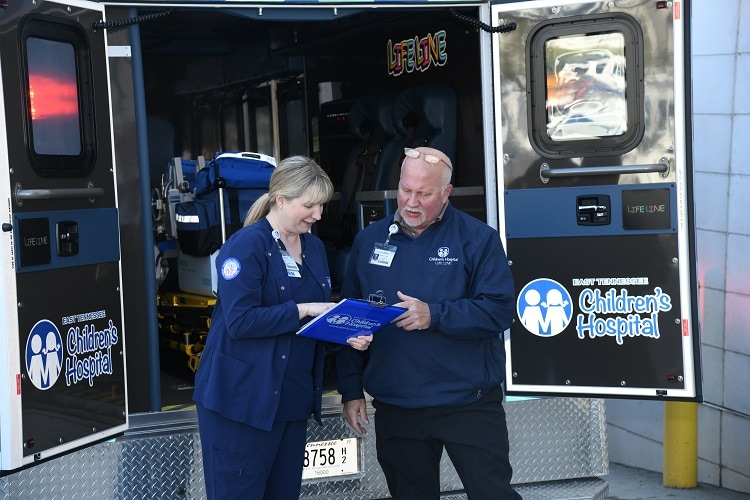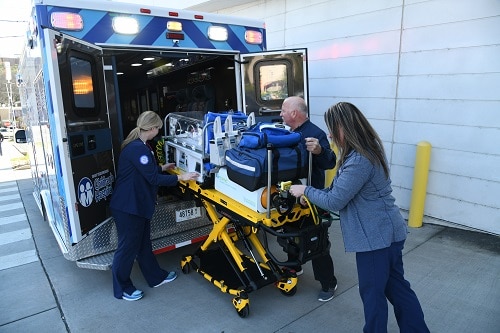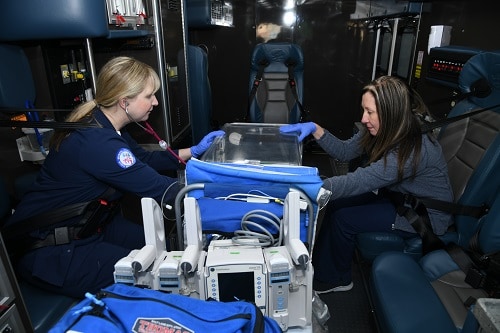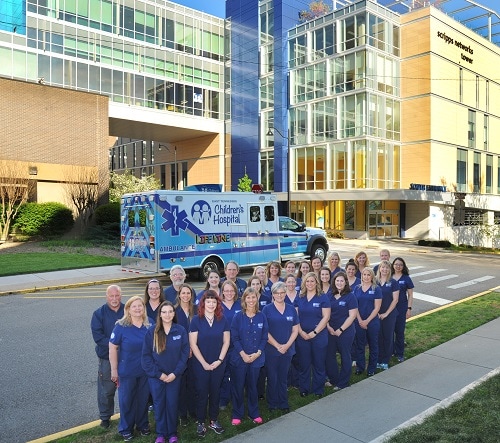Lifeline Ambulance
 East Tennessee Children's Hospital's Lifeline ambulances are custom-made neonatal/pediatric transport vehicles equipped like a mobile intensive care unit. They are designed to transport premature babies and other pediatric patients from hospitals in surrounding areas to Children's Hospital. Enough supplies are on the ambulance that any size patient, from a premature infant to a 21-year-old can be cared for during transfer to the Children's Hospital NICU or PICU. Lifeline does more than 500 transports and travels over 40,000 miles each year.
East Tennessee Children's Hospital's Lifeline ambulances are custom-made neonatal/pediatric transport vehicles equipped like a mobile intensive care unit. They are designed to transport premature babies and other pediatric patients from hospitals in surrounding areas to Children's Hospital. Enough supplies are on the ambulance that any size patient, from a premature infant to a 21-year-old can be cared for during transfer to the Children's Hospital NICU or PICU. Lifeline does more than 500 transports and travels over 40,000 miles each year.
Proceeds from the 2022 Fantasy of Trees celebration were used to purchase a new Lifeline ambulance to serve the emergency needs of children in our community. This ambulance will be delivered in spring 2025. It will replace a 2011 Lifeline Ambulance that has accumulated over a quarter-million miles.

Instead of rushing a patient to the hospital, the hospital is sent to the patient. Our Lifeline ambulances are a vital part of the lifesaving care we provide to children in East Tennessee.
Level of Care

The Lifeline team is highly skilled. The team consists of specially trained transport nurses and respiratory therapists, as well as AEMTs and paramedics. The AEMT or Paramedic drives the ambulance, and assists with stabilizing patients at outlying hospitals. During transport, there is always a specially trained nurse and a respiratory therapist in the back with the patient. Depending on the severity of the patient, doctors, nurse practitioners, and more nurses may join the team.
- Lifeline transports the smallest babies (weighing as little as a pound) to teenagers and young adults. Children’s Hospital treats birth to age 21. Lifeline carries equipment to treat all ages and all sizes.
- These are the only ambulances in the area that can transport twins or two patients at once. In this case, another nurse and respiratory therapist joins the team, making a total of five highly-trained caregivers on-board, if not more.
- Just like in an intensive care unit, there are backup systems in place should the need arise. Lifeline has its own generator, oxygen tanks, suction, and other monitoring systems required for life support.
- Lifeline is more child-friendly than routine ambulances. For older patients, they have an iPad and the ability to play movies during longer transports.
- Lifeline is capable of ventilator/life support, giving IV fluids, drawing blood for lab work to reduce wait time once a patient arrives at Children’s Hospital, monitoring capabilities, total body cooling and more.
Lifeline Facts
 The transport service at Children’s Hospital began in 1980 with the first Lifeline ambulance; there have been four ambulances since then, making our newest ambulance Lifeline 5. Lifeline 6, a 2024 International Crew Lab Ambulance, will arrive in spring 2025.
The transport service at Children’s Hospital began in 1980 with the first Lifeline ambulance; there have been four ambulances since then, making our newest ambulance Lifeline 5. Lifeline 6, a 2024 International Crew Lab Ambulance, will arrive in spring 2025.- The average ambulance costs approximately $150,000. Lifeline - a custom, critical-care ambulance - is three times more expensive than a normal ambulance.
- Children’s Hospital is the only hospital in Knoxville (and within 100 miles) to have ambulances of this caliber.
- At any given time, there are two transport teams at-the-ready at Children’s Hospital. The team that goes depends on the age of the patient. Children’s Hospital has a team for neonatal babies and a team for pediatric patients available 24/7.
- Lifeline is designed specifically for babies and children, and it provides the space and electrical outlets needed for all of the specialized equipment needed for these patients.
Where They Travel
 Lifeline is an intensive care unit on wheels. While our team may rush to get to a hospital, once the patient is on-board, the team focuses on the stability of the patient. With the high skill level of staff and the equipment they have at their fingertips, Lifeline is rarely in emergency traffic on the way back to Children’s Hospital. They can treat patients just as if they were in the ICU.
Lifeline is an intensive care unit on wheels. While our team may rush to get to a hospital, once the patient is on-board, the team focuses on the stability of the patient. With the high skill level of staff and the equipment they have at their fingertips, Lifeline is rarely in emergency traffic on the way back to Children’s Hospital. They can treat patients just as if they were in the ICU.- Lifeline is a facility-to-facility transport ambulance; it travels to hospitals across East Tennessee and Southeast Kentucky to pick up critically ill newborns and pediatric patients.
- Lifeline is called for more than 500 transports and travels over 40,000 miles annually.
- The average trip is 50-60 miles one-way, traveling to hospitals in communities such as Morristown, Sevierville, Crossville, and Oak Ridge.
- Lifeline travels to more than 25 hospitals throughout East Tennessee and Southeast Kentucky. Lifeline and the crew are also equipped to travel longer distances. On average, they make a trip to Kentucky, Nashville or the Tri-Cities about once a week.
- Once the transport team arrives, the patient is stabilized and brought back to Children’s Hospital. The average transport is 3-4 hours round-trip.
Total Body Cooling
 Total body cooling is treatment for babies who go without oxygen or decreased blood flow to the brain for an amount of time during birth.
Total body cooling is treatment for babies who go without oxygen or decreased blood flow to the brain for an amount of time during birth.- This process places newborns on a water-filled cooling mattress to reduce the body temperature for three days. This is long enough to reverse possible brain injury. After three days, the newborn returns to a normal body temperature in the NICU with continuous monitoring.
- The sooner a baby begins cooling after a traumatic birth, the better the outcome. Often, the referring hospital is more than an hour away. Lifeline is the only ambulance in the area to offer total body cooling beginning at transport—where minutes matter the most.
- With this technology, Children’s Hospital has seen infants leave in as little as 10 days where otherwise they would have expected them to be in the NICU for months.